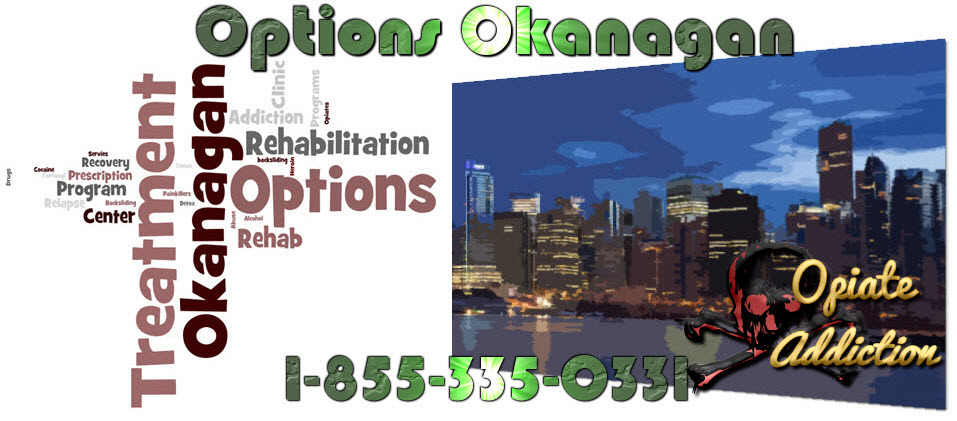Timeline For Opiate Withdrawal in Vancouver and Calgary for drug addiction by Options Okanagan Treatment Center in Kelowna, British Columbia treating Opiate addiction and recovery.
Luxury Drug Rehab Treatment Center
It is definitely advantageous to be thoroughly familiar with the timeline for opiate withdrawal, especially since it will help to ensure that you don’t panic whenever withdrawal symptoms start to appear.
Opiates are a type of narcotic opioid alkaloid that is derived from the opium poppy plant. Although opiate drugs such as papaverine, codeine and morphine are found within the opium itself, oxycodone, hydrocodone and heroine are derived from codeine and morphine. When a person suddenly stops taking one of those drugs, it can trigger a wide range of withdrawal symptoms, from severe anxiety to diarrhea. Depending on the specific opiate you were using, for how long, and the amount, your withdrawal symptoms could last from a week up to several months.
Note: In this case it can be hard tracing a precise withdrawal symptoms timeline, since it differs from one individual to the next. Most importantly, for those who really go through with the withdrawal process, they are usually not in a position to track the symptoms they are experiencing. Therefore, data that has been collected from different cases must be relied upon to develop a generic timeline. The timeline only provides you with a rough overall idea of what to expect in terms of what is coming your way rather than a precise chronology of events. That is why it is a smart ideal to consult with a physician in order to rid yourself of any doubts you might have about the withdrawal process or getting yourself admitted into a rehabilitation facility where the whole process will take place with experts watching over you.
Opiate Withdrawal
‘Opiate withdrawal’ is a term referring to a range of symptoms experienced by an individual when he reduces or stops using opiate drugs after he has used them for a long period of time. People who abuse drugs are not the only ones who experience withdrawal symptoms. There also commonly occur in individuals who use prescription medications- in particular pain relievers- that contain synthetic opiates such as hydrocodone and oxycodone.

In fact, an individual who stops taking heroin at least is aware the he is going to experience withdrawal symptoms over several days. However, an individual who becomes addicted to a medication that has been prescribed to them won’t be aware of potentially getting withdrawal symptoms. He will instead be more likely to think that the symptoms are coming from the illness that he was prescribed the medication for and continue his dosage.
Timeline For Opiate Withdrawal Symptoms
No matter what drug it is, the withdrawal symptoms for it can vary from one individual to the next, since there are several different factors that determine how intense the symptoms will be. The occurrence of symptoms will mainly depend on the specific drug that has been abused. When it is opiate drugs such as heroin, they start to appear in under 24 hours. However, in cases where it is a prescribed medication that is responsible, it might take a whole day before any symptoms begin to surface. Symptoms on average start to surface within 8 to 16 hours after the last time the drug was used. In some individuals, however, it won’t be obvious until at least 24 hours have passed.

Phase 1 (Days 1-3) Briefest, but hardest phase.
Depending on what level you use, you might start to feel restless after a certain period of time. As time starts to elapse, other symptoms, such as dilated pupils, diarrhea, vomiting, nausea, sweating, watery eyes and running nose will make you even more restless. As time continues to progress, you will start to become agitated for no specific reason. It will be accompanied by insomnia and anxiety. You will be unable to sleep, and if you are able to, you may wake up in a cold sweat.
A majority of the symptoms start within 36 to 48 hours after the drug has been used last. In addition to this, you might also experience goose bumps and involuntary twitching. You most likely won’t feel like eating, and if you attempt to eat, you probably will throw up. Your body at this point will be facing a severe lack of nutrients, and therefore drinking lots of fluids is very important even if you end up needing to spend the whole day in the bathroom.
You will also be experiencing muscle ache as well as localized pain in different parts of your body, including legs, back and abdomen. The pain at times will become unbearable. You may want to take an epsom salt bath in order to help esae the pain. These symptoms will continue to get worse over time and reach their peak sometime in between 48 and 7 hours after last using the drug (most likely during the third day of your withdrawal) and then start to ease gradually.
Read Phase 2 and Phase 3 Next Article
Options Okanagan Opiate and Alcohol Treatment Centers in Kelowna, Salmon Arm and Vancouver, British Columbia – Men and Women are recovering and healing from Alcohol and Drug Abuse at our treatment center here in the Okanagan right now.

Our unique and distinctive Opiate Drug and Alcohol treatment program allows men and women to come in from Calgary as well as Edmonton as we offer airport pickup.
Numerous clients come to us from Vancouver, Calgary and Edmonton and other locations in Alberta and even other provinces for Opiate addiction treatment, meth drug treatment, many other drug and alcohol addictions for rehabilitation because of the uniqueness of our treatment center.
Our Treatment Location:
Options Okanagan Opiate Treatment Center
206 – 478 Bernard Avenue, Kelowna, British Columbia, V1V 2E6
Toll Free Phone Number : 1-855-335-0331

